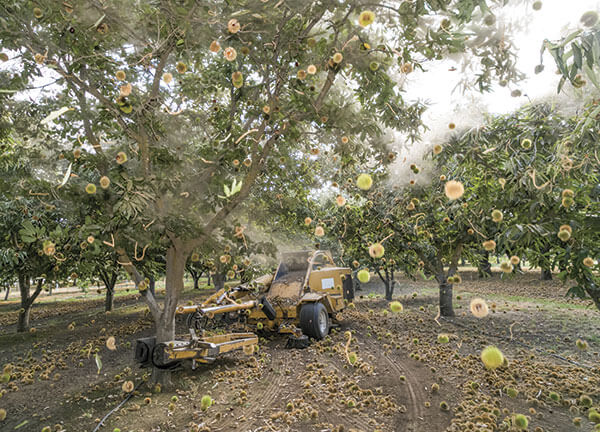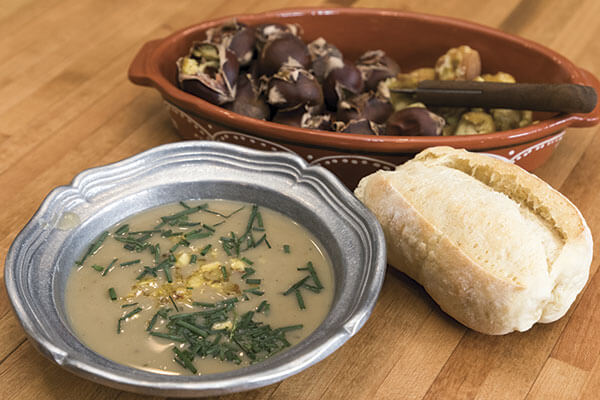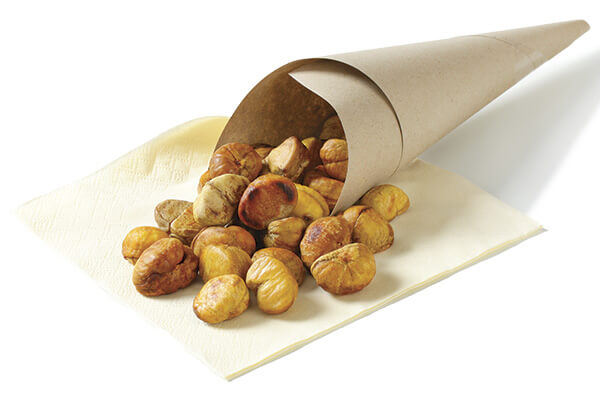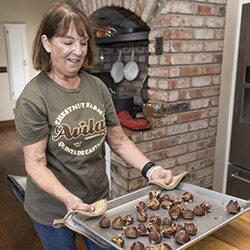
California chestnuts
September/October 2019 California Bountiful magazine
Story by Christine Souza
Photos by Richard Green
A tasty tradition inspired by Azorean heritage

Harvesttime is a rewarding time for chestnut farmers Joe and Jenni Avila, left, with son Shane Avila, daughter Laci Anderson and son-in-law Kenny Anderson. The nuts, harvested in September and October, are sold locally and shipped to customers across the country. Photo: © 2019 Richard Green
September 15, 2019 - By Christine Souza - Joe Avila has many fond memories of a boyhood spent in the Azores islands of Portugal. Among them is his childhood love of eating chestnuts with his "Avó" (grandmother) Rosa, who would boil the hard-shelled nuts that she and the family collected from trees outside her home.
"My cousins and I and my mom and her family would help her pick the chestnuts up," Avila said. "My avó was pretty stingy with her chestnuts, because she would sell them to fellow villagers on the island of Terceira. It was the late 1950s, and you had to do what you had to do."
Avila, who immigrated to the United States at age 12 with his parents, now owns The Chestnut Farm, or "Quinta de Castanhas," in Modesto with his wife, Jenni.
Joe Avila said his grandmother "typically served boiled chestnuts on birthdays and special occasions," adding that she and other women in the family worked hard, cooking and baking for fellow islanders.
While the women worked inside, young Joe was outdoors cutting hay and milking cows on a farm his family worked for other people. This connection to the land has never left Avila, who also spent a career in landscape maintenance.
Inspired by memories of time spent with his avó and family in the Azores, Avila decided in the early 1980s "to plant a few chestnut trees like my grandmother had back in the old country."


A machine in the Avilas' orchard shakes the trees to knock the chestnuts to the orchard floor. Another machine picks them up and removes the spiny green husks. Photo: © 2019 Richard Green
Harvesting a family tradition
The first block of three-dozen trees has expanded to about 7 acres of trees today.
"After that (first planting), each year for several years I planted an additional acre of chestnut trees that I had grafted," said Avila, who also grows Fuyu persimmons and Kabocha squash.
Varieties include the European Colossal chestnut—a hybrid of Japanese and European varieties resistant to chestnut blight, which virtually destroyed the native American chestnut in the mid-1900s. The family also grows an accompanying pollinator, the Nevada chestnut. Avila said the two trees are planted together and depend on wind pollination to set the crop.
Jenni Avila describes her husband's chestnut trees as "like his babies," adding that farming chestnuts "is something that I look forward to every year. It means a lot of work also, but I'm very proud of him and what he's done."
Harvest is a family tradition at The Chestnut Farm. Beginning in mid-September and continuing through mid-October—and with help from their son Shane, and daughter and son-in-law Laci and Kenny Anderson—the Avilas shake the trees and collect ripened chestnuts that have dropped to the orchard floor.
"When the chestnuts start dropping too much, then it's impossible to try to pick all of those by hand. I sweep them into a row and I have a machine that picks up the loose ones, picks up the ones in the burr (spiny husk), and de-burrs the ones in the burr," Joe Avila said.
Employees at the farm sort the chestnuts and run them through a sizer, which organizes the nuts into four sizes, then loads them into 25-pound bags.
Following harvest, chestnuts are placed into cold storage and marketed through November, with prices ranging from $2.75 to $4.50 per pound, depending on nut size.
"Chestnuts are a real unique and specialty item, and there are not many planted in California and in the United States," Jenni Avila said. "When we first started growing them, we used to go to farmers markets and sell them, and pretty soon it was just more efficient to tell people to stop by our farm."


With their sweet, earthy flavor, chestnuts are a welcome ingredient across the menu, such as in an Avila family favorite: soup. Photo: © 2019 Richard Green
A seasonal treat and a taste of home
University of California Cooperative Extension Farm Advisor Emeritus Paul Vossen says there are just a few small-scale chestnut growers in California, who mostly sell directly to customers.
"Americans typically only buy chestnuts around the holidays, from Thanksgiving to Christmas," Vossen said. "They buy them and roast them on an open fire—you know the song. That's the major part of the market."
One advantage for California farmers, he said, is that chestnuts mature before Thanksgiving, providing an early market.
Known as "the chestnut man," Joe Avila sells chestnuts directly to farm visitors or ships them to customers around the country in 10-pound and 18-pound boxes. Each fall, he also attends several Portuguese festas, or festivals, where he either sells or donates chestnuts, a treat that reminds fellow Azoreans of home.
But it's not just people from Portugal who seek out chestnuts this time of year.
"We sell to many nationalities in California, and Jenni ships a lot of chestnuts around the U.S.: Italians like to roast chestnuts, Portuguese boil them, Bosnians roast them and Asians boil them," Avila said.
For many of the farm's customers, Jenni Avila said, "chestnuts remind them of their upbringing and home country, or remind them of a trip they've taken in other parts of the world."
For example, she said people of Bosnian descent arrive at the farm each fall to purchase chestnuts.
"They come to the farm in a three-car caravan and bring their kids. They've told me that they gather to roast chestnuts in one of the family's backyards," she said.
 Roasted and peeled chestnuts, served in paper cones, are popular at some wintertime festivals. Photo/Shutterstock
Roasted and peeled chestnuts, served in paper cones, are popular at some wintertime festivals. Photo/Shutterstock
Satisfying snack and versatile ingredient
Chestnuts are sweet, with a mild flavor, Joe Avila said, noting that unlike walnuts and other hard nuts, they are soft but still firm when cooked and have a grain-like texture.
Chestnuts are rich in nutrients such as vitamin C and fiber and, unlike other nuts, contain just a trace of fat, according to the Chestnut Growers of America.
Joe Avila said his favorite way to eat chestnuts remains the way he ate them as a boy: boiled.
"They have the texture of a sweet potato," he said.
Each fall, recipes celebrating chestnuts begin to appear, including traditional uses such as in turkey stuffing or the "roasting on an open fire" immortalized in song.
"Eating them like a snack is the go-to way," Jenni Avila said, "but I've used them in soups or as a substitute for meat, as in a spaghetti sauce, and I've made a squash soup and used crumbled, sautéed chestnuts as a garnish. I've also sautéed them in a little bit of butter until they are caramelized and put them on top of vanilla ice cream.
"I like chestnuts and I like it when he cooks them," she said of her husband. "They go great with a glass of wine, especially on a cold day."
Christine Souza
Recipe
 (Left) Chestnuts can be roasted, as Jenni Avila demonstrates, or boiled. Once cooked, they have a grain-like texture. Photo: © 2019 Richard Green
(Left) Chestnuts can be roasted, as Jenni Avila demonstrates, or boiled. Once cooked, they have a grain-like texture. Photo: © 2019 Richard Green
How to store and cook fresh chestnuts
You bought fresh chestnuts! Now what? First, they must be properly stored.
"They need to be treated like a fresh vegetable," said Jenni Avila of The Chestnut Farm in Modesto.
Store chestnuts in a breathable, mesh bag in the refrigerator until you're ready to cook them, she said. They'll last a few weeks in the vegetable crisper.
They may also be stored in storage bags in the freezer for later use, Avila said. This can be done without cooking them, but she said most people prefer to boil and then freeze them already cooked.
When you're ready to cook your chestnuts, first let them sit on the counter for a day to allow a little dehydration to aid in peeling, Avila said.
"If you are new to chestnuts, it is probably best to begin by boiling," she said.
Larger chestnuts, about 1 1/2 inches in diameter, require about an hour in gently boiling water. Medium-sized chestnuts measuring 1 1/4 inches need about 45 minutes, and those an inch or less in diameter take about 35 minutes.
If roasting is your preference, you first need to score the chestnuts, cutting an "X" into the flat side of each nut with a sharp paring knife. Then roast them on a cookie sheet in a 350-degree oven until the peel starts to curl back. Larger chestnuts may take 30 minutes, whereas smaller nuts may be done in 15 to 20 minutes. If roasting outdoors over the barbecue, take care not to overcook or the chestnuts will be too hard, Avila said.
Once cooked, let the chestnuts cool, then peel and enjoy—just as they are or in your favorite recipes.
Reprinted with permission: California Farm Bureau Federation








